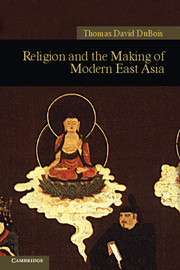Book contents
- Frontmatter
- Contents
- List of Boxes, Figures, and Maps
- Preface
- 1 In the beginning: Religion and history
- 2 Ming China: The fourteenth century's new world order
- 3 The Buddha and the shōgun in sixteenth-century Japan
- 4 Opportunities lost: The failure of Christianity, 1550–1750
- 5 Buddhism: Incarnations and reincarnations
- 6 Apocalypse now
- 7 Out of the twilight: Religion and the late nineteenth century
- 8 Into the abyss: Religion and the road to disaster during the early twentieth century
- 9 Brave new world: Religion in the reinvention of postwar Asia
- 10 The globalization of Asian religion
- Glossary
- Timeline of dynasties and major events
- Suggestions for further reading
- Index
2 - Ming China: The fourteenth century's new world order
Published online by Cambridge University Press: 05 June 2012
- Frontmatter
- Contents
- List of Boxes, Figures, and Maps
- Preface
- 1 In the beginning: Religion and history
- 2 Ming China: The fourteenth century's new world order
- 3 The Buddha and the shōgun in sixteenth-century Japan
- 4 Opportunities lost: The failure of Christianity, 1550–1750
- 5 Buddhism: Incarnations and reincarnations
- 6 Apocalypse now
- 7 Out of the twilight: Religion and the late nineteenth century
- 8 Into the abyss: Religion and the road to disaster during the early twentieth century
- 9 Brave new world: Religion in the reinvention of postwar Asia
- 10 The globalization of Asian religion
- Glossary
- Timeline of dynasties and major events
- Suggestions for further reading
- Index
Summary
Religious foundations of late imperial China
Religion in China is both singular and plural. For the great majority of Chinese people today, religion consists of a combination of three distinct traditions: Confucianism, Daoism, and Buddhism. Each of these traditions can be seen as its own intellectual and organizational entity, and this chapter will begin by presenting each one separately. In practice, few believers would think to choose one over the others. The idea of exclusive religious membership, that one should be a Buddhist or Daoist, but not both, simply does not apply. Even those believers who are particularly devoted to one teaching will often incorporate elements of the other two, sometimes without even recognizing them as such. The point is not that Chinese people are irreligious. Quite the contrary: the “three teachings,” as they are called, are inseparable parts of a single system of beliefs, morals, and rituals that pervades Chinese life.
It was not always so. The three teachings evolved in relation to, and sometimes in conflict with, each other. The current state of equilibrium is relatively recent, at least by Chinese standards, meaning that it is less than a thousand years old. Before that time, the balance among the three teachings was much more fluid, and occasionally more violent, than what we see today.
Confucianism
Properly speaking, Confucianism is less a religion than a political philosophy, one that developed long before the birth of Confucius himself.
- Type
- Chapter
- Information
- Religion and the Making of Modern East Asia , pp. 15 - 52Publisher: Cambridge University PressPrint publication year: 2011

